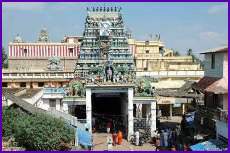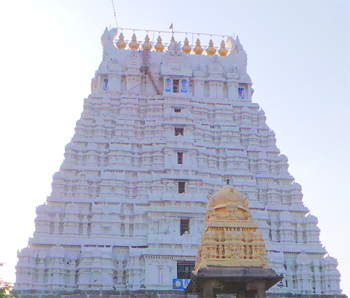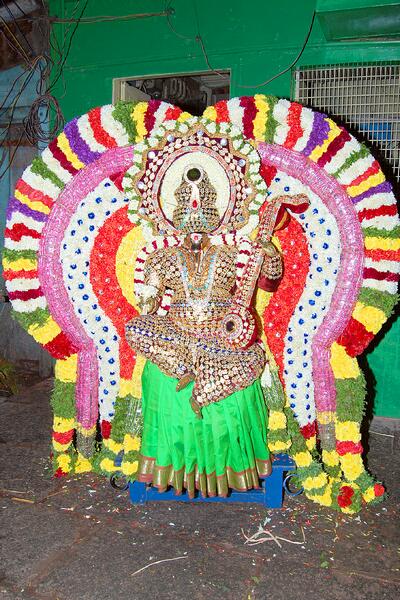Main God:
Arulmigu Swaminatha Swamy

Location :
Arulmigu Swaminatha Swami Temple,
Thirumanjana Veedhi,
Swamimalai,
Thanjavur – 612302
Festival :
Krithigai is an important festival celebrated in the Tamil month of Adi or Aadi. The festival is dedicated to Lord Muruga or Subrahamaniya. Incidentally, the festival is also referred as Aadi Krittika, Kirthigai, Kritika and Krithika. The festival is celebrated with fervor in the Murugan Temples in Tamil Nadu.Krithigai in some regions is celebrated to symbolise the victory of good over evil, when Murugan slew the demon Surapadma. After the annihilation of the demon, Muruga blessed devotees with boons.

Temple Car Festival
Navaratri is a festival dedicated to the worship of the Hindu deity Durga. The word Navaratri means ‘nine nights’ in Sanskrit, nava meaning nine and ratri meaning nights. During these nine nights and ten days, nine forms of Devi are worshipped. The tenth day is commonly referred to as Vijayadashami or “Dussehra” (also spelled Dasara). Navaratri is an important major festival and is celebrated all over India and Nepal. Diwali the festival of lights is celebrated twenty days after Dasara. Though there are total five types of Navaratri that come in a year, but Sharad Navaratri is the most popular one. Hence, the term Navaratri is being used for Sharada Navaratri here.
The hallowed full moon day in the month of Vaikāsi, under the Visākam star is the Vaikāsi Pournima also termed Vaisāki Paurnima. The Vaikāsi moonlight floods the world with a glorious effulgence making the over arching sky infinite and vast. In our tropical skies, the moon, ‘slowly and silently walks the night in her silver shoon.’ The transparent clouds seem to salute her as she moves unhurriedly. This is indeed Nature’s magnificence manifesting itself with an overwhelming grandeur. And with this mysteriously beautiful soft light of sanctity, comes a hush, deep and strange reminding the Hindus and Buddhists of the significance of this sacred day.
This month is special because the Uthiram nakshatram coincides with the full moon. This full moon signifies the marriage of Parvati and Parameswara (Lord Shiva), Murugan and Deivanai, and Aandaal (also known as Kothai) and Rangamannar took place. On Panguni Uthiram, Narayana marries Komalavalli Naachiyar and give his Kalyana Kola Seva to his Bhakthas. Again, Valmiki’s Ramayana says it is on this day and star that Sita’s marriage with Rama was celebrated. From Brahmanda Puranam we learn that on Panguni Uthiram every holy water joins Thumburu teertha (also spelt as Tirtha), one of seven sacred tanks in Tirupati Tirumala.

Skanda Sashti is observed on the sixth day of the bright fortnight of the Tamil month of Aippasi (October – November). This day is dedicated to the second son of Lord Shiva – Lord Subramanya, also known as Kartikeya, Kumaresa, Guha, Murugan, Shanmukha and Velayudhan, who on this day, is believed to have annihilated the mythical demon Taraka. Celebrated in all Shaivite and Subramanya temples in South India, Skanda Sashti commemorates the destruction of evil by the Supreme Being.
Many legends and lyrical poetry have grown round this star. The six stars are considered in Indian mythology as the six celestial nymphs who reared the six babies in the saravana tank which later were joined together to form the six faced Muruga. He is therefore called Karthikeya, the incarnation of lord Shiva as his second son after lord Ganesha. Stories tells lord shiva created Muruga from his 3rd eye of six primary faces (Tatpurusam, Aghoram, Sadyojatam, Vamadevam, Eesanam, Adhomukam). Stories tells the six forms made into six child and each of them brought up by the six Karthigai nymphs and later merged into one by his mother Parvati.While merging he also formed into a six faced (Arumugam and twelve handed god. The Lord muruga is also portrayed with his six plays and worshiped with six names.As the six nymphs helped in growing the six child, lord shiva blessed immortality to the six nymphs as ever living stars on the sky. Any worship performed to this six stars is equal to worshiping lord muruga himself. They are worshiped by lit up with rows of oil lamps (Deepam) in the evening of the festival day around the souses and streets. Karthikai Deepam is also known as Kartikeya, or Muruga’s birthday.

Workship Timing :
Morning Open 05:00 A.M
Morning Close 12:00 Noon
Evening Open 04:00 P.M
Evening Close 10:00 P.M
History :
The temple of Swaminatha is very ancient one and it is known to have existed even in the 2 nd century BC. It is said that Parantaka Chola I built the temple. The temple was damaged to a great extent and the Gopurams were demolished and razed to ground in the year 1740 when the Anglo-French War was waged later when war broke out between Hyder Ali and the British.Swamimalai is fourth among the six padai veedu or sacred shrines dedicated to Lord Muruga. The presiding deity here expounded the meaning of the Pranava mantra OM to his own Father Lord Siva Himself.
Mythology says that saint Bhrugu before commencing an arduous tavam or penance, got the boon that anybody disturbing his mediation will forget all his knowledge. Such was the power of the penance that the sacred fire emanating from the head of the saint reached up to the heavens, and the frightened devas surrendered to Lord Siva praying for his grace. The Lord extinguished the sacred fire by covering the saint’s head by hand. With the saint’s penance thus disturbed the Lord became oblivious of all his knowledge and is said to have regained them by learning the Pranava mantra from Lord Muruga at this shrine.

Once when Brahma, the lord of all creations was proceeding to Kailasa, the ever-playful child Lord Muruga asked him for the meaning of the Pranava OM. When Brahma admitted his ignorance, the Lord imprisoned him. With Brahma imprisoned, all creations came to a standstill and the devas prayed to Lord Siva to get Brahma released. When Muruga insisted that the imprisonment was a just punishment for the ignorance of Brahma, Lord Siva asked him whether he himself knew the meaning of the primordial Pranava OM. Lord Muruga said that he knew the meaning of OM and can expound it to the latter only if he can accept him as guru and listen to the exposition as a devoted disciple. As Lord Siva acceded to the request of Lord Muruga and heard the exposition of OM as a disciple, the place came to be known as Swamimalai and the presiding deity as Swaminathan.
The temple is built on an artificial hillock of about sixty feet height with sixty beautifully laid stone steps representing the Hindu cycle of sixty years – leading to the Lord . In the ground floor there are temples dedicated to Lord Sundareswarer and Goddesss Meenakshi.

Hymns in praise of the presiding deity have been sung by saint Nakkeerar in Tirumurukatrupadai and by Saint Arunagirnathar in Tiruppukazh












